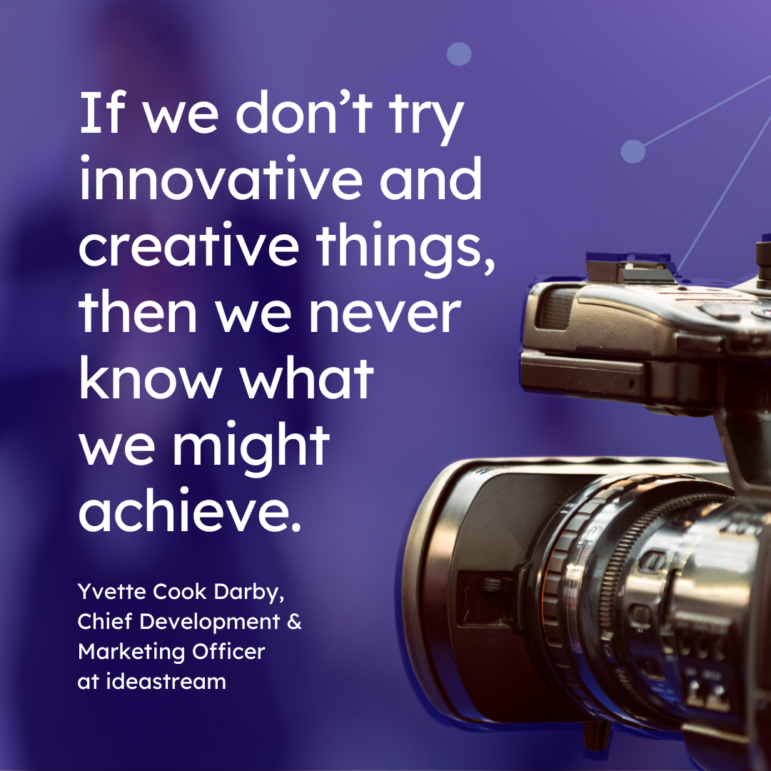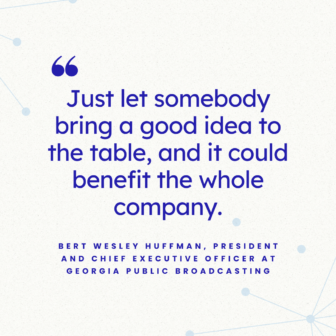How to achieve real change in fundraising practices at your station
SPONSORED
It’s hard to achieve consensus in most situations. However, one thing public media executives seem to agree on is that change is needed — especially regarding fundraising practices.
The current landscape is plagued with uncertainty. And while there have been plenty of efforts to revamp, reimagine, and even redefine fundraising in the public media sector, many executives believe more work is needed.
“We have a daunting challenge ahead of us,” said Brenda Barnes, CEO of Classical KING.
To rise to this challenge, public media fundraisers and executives will need to develop new skills. They must be willing to get creative, connect with others in the industry, and — most importantly — take chances, even if they fail.
Moving quickly is critical. Competition will only continue to grow, so leaders must act with urgency.
Freedom to fail
The future of public media is uncharted. As such, fundraisers and marketers must have the leeway to try new things. An untested tactic that doesn’t work isn’t a failure; it’s a learning opportunity.
“I think what I bring to this is more patience than I used to have and less frustration with failure,” Delaney said. “Failure really is learning. It’s analyzing what our experiences have been and saying what could be improved or what we could let go of. It’s just looking for the learning that comes from it rather than the neat, tidy outcome.”
At Nebraska Public Media, Delaney and her team are experimenting with pledge. When evaluating how to do things differently, Delaney considers how much time an experiment would take and whether it would be worth the potential payout. Because pledge is already declining, it’s an area where you can take more manageable risks.
To move forward, public media executives must give their teams permission to fail. Otherwise, they might never know what they can achieve.

Yvette Cook Darby, Chief Development and Marketing Officer at ideastream Public Media, has a basket labeled “Big, Hairy, Audacious Ideas.” People can drop anonymous ideas in the basket, which she collects and reviews with her team’s directors. The entire ideastream team then meets each month to vote on an idea to try. This has proved to be a safe way to encourage team members to be creative.
Where do good ideas come from?
As Darby has learned, innovation doesn’t happen when you stand still. If you want creative ideas, you must get creative in how you source them.
Bert Wesley Huffman, President and Chief Executive Officer at Georgia Public Broadcasting (GPB), believes great things happen when you give people an opportunity. Each month, 10 employees are chosen at random to have lunch with Huffman. In many cases, those selected may not even know each other well.

The ideas that spring from this lunch are presented to the Employee Council. If the council thinks the idea has merit, it will be presented to the leadership team.
“Just let somebody bring a good idea to the table, and it could benefit the whole company,” Huffman said.
Huffman also believes in sourcing innovative ideas from both inside and outside the organization, especially when it comes to motivating your team. A suggestion that’s been floated several times from within the organization can suddenly sound revolutionary coming from a consultant. Engaging an outside partner can energize your team in a new and fresh way.
How to find the right partner
When engaging an outside partner, a full-service agency will be best equipped to help you educate and encourage staff, dig deep into your fundraising program, make data-driven recommendations, and execute with excellence.
As you evaluate agencies, look for an agency that offers expertise in public media but works with other types of nonprofits as well. In addition, look for a partner with specialists or departments in key program areas. These include analytics, strategy, digital fundraising (email), digital advertising, creative (copy and design), and production management.
Challenge your agency partner for new ideas. To kick off this discussion, you might ask:
- What one or two new things do you think would have a positive impact on our program?
- Where do you think we’re not leaning in enough?
- How could you be better positioned to help us?
Also, consider adding an opportunistic testing budget to try new initiatives that emerge as the year unfolds. This could be as much as 10% of your direct response (mail and digital) budget.
Overcoming inertia
Public media stations are full of bright, young, intelligent people with a lot of energy and ideas. However, they may be up against managers who have been in the business for decades. It can be easy to get stuck using the same old tactics, particularly when it comes to fundraising.
Of course, it can be difficult to break people out of their routines. Whether you’re navigating emotions, personalities, or organizational silos, it’s often a tall task. This is where an agency partner can provide an objective view of the landscape.
“There’s a sense of loss that comes with big change,” said Laura Barnett, Director of Development at Austin PBS. “If you’re at an organization that’s experiencing a lot of change, there are also people who are going through a lot of loss, and there are emotions and feelings that come with that.”
One essential step is to have an outside agency or partner conduct a fundraising audit. Doing so will identify current program strengths, weaknesses, and areas of opportunity. The presentation of the audit findings is a chance to bring together team members from multiple disciplines and all levels of the organization.
Your agency partner should present their findings, provide actionable recommendations, and moderate a discussion among all station stakeholders. This is one way to break down the inertia that sometimes exists at a station and get team members excited about being part of real change.
How do you eat an elephant? One bite at a time.
Fundraising and marketing teams tend to have some big ideas, especially when facing uncertain times. However, leaders may not be willing to take such a large risk. If you don’t feel like you can get traction on your initiatives, show that incremental change is possible. Small steps will still move the needle and help you mitigate risks. If only two steps of your 10-step plan get approved, it’s not a failure; it’s a perfectly reasonable fallback position.
“Build on what you already have, rather than starting something from the ground up,” said Minnie Prince, Chief Philanthropic and Community Development Office for Classical California KUSC/KDFC.
It’s essential to spotlight the things you’re currently doing. Take an inventory of what you’ve accomplished and think about how you can build on existing efforts at the station. Also, don’t give up if your entire plan isn’t approved immediately. Taking things slowly and testing along the way can be highly beneficial. Specifically, it can give you the data you need to prove the value behind your idea.
The looming challenges that public media professionals face will create many opportunities, especially for people with digital expertise and knowledge.
If you don’t feel heard in your organization, your agency partner should be able to help you refine your idea. They can share insights and experiences using the same strategy at other stations. More importantly, they can help you put some cost and revenue expectations around your idea, which should help you sell it within your organization. “Equip yourself with data,” Delaney said. “Changes only happen when people do the research. Examine something thoroughly and prepare to defend it.”
Strength in numbers
As an industry, public media comprises dedicated professionals who are amazingly generous with their time and talents. The importance of building a network can’t be overstated.
Huffman encourages fundraisers and marketers to connect with their peers at other stations and discuss what works and what doesn’t. The challenges facing the public media industry are generally consistent across stations and markets. We all have knowledge to share.
“That’s one thing I want to do for people at GPB — create those nationwide lifelines and find people who are doing things really well and just pick their brains,” he said. “You know, we have more in common than what differentiates us.”
Embracing the old and the new
Public media’s work is critical. For much of your audience, you serve as a window to the wider world of art, culture, and entertainment.
“There are so many people whose quality of life depends on us,” said Coby Cartrette Hennecy, Executive Director at the ETV Endowment of South Carolina. “They’re not going to travel. They’re not going to go to performances. They are not going to be able to take the trip. And yet, from the comforts of their own home, we can do it.”
Of course, delivering this work takes money. To grow your revenue, you must invest in fundraising and marketing efforts. Take things slowly. Use data to support your ideas. Talk to your peers.
“Never apologize for trying to raise money,” Hennecy said. “The world is changing. Our distribution channels have changed. Therefore, the way we reach people, and the way we solicit money, and the way we fundraise has to change. It’s embracing the old with the new.”
If you’re ready to try something new, reach out to our team at Allegiance Group + Pursuant. You can also download this free resource, “The Request For (A New) Proposal Process” to transform your approach to RFPs.


